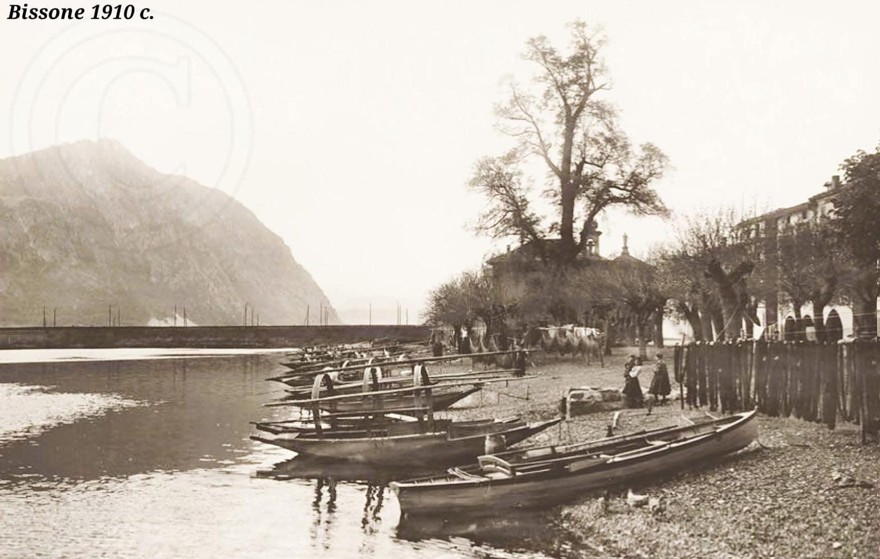The winds
Fishermen knew how to foretell the changing of weather conditions by reading the cloud movements and watching where air currents came from. Their lives and the safety of their boats indeed depended on their ability to know the winds and their effect on the lake. Here are the winds that have blown for centuries on Lake Ceresio.
- Breva, which usually picks up mid-morning and peters out towards evening. It is a light wind. It blows from Porto Ceresio to below Monte Brè and always indicates good weather on the lake.
- Caronasca, which blows down from Carona towards Campione. It’s a stormy wind, blowing hard until the storm breaks. It dies down when the rain starts.
- Porlezzina, which blows from Porlezza towards Paradiso and tells of storms in the Chiavenna and Sondrio areas and on Lake Como.
- Tramontana, , which blows down from the mountains surrounding the lake at sunset.
- Pontetresa, a stormy wind coming out of the Ponte Tresa-Lavena Gulf and capable of making navigation rather tricky.
- Marino, a wind feared by fishermen as it can reach up to 120km/h and generate high waves. It blows from Capolago towards Melide, and from Porto Ceresio to Agno.
- Vento del Nord, a cold wind blowing down from Monte Bar and the Vedeggio Valley towards Porto Ceresio, and capable of reaching up to 90-100 km/h.
- Tivano, a stormy wind blowing down from Osteno towards the slopes of Monte Brè forming characteristic eddies which lift up the water like fine dust up to 50-100 m in height. It is rather infrequent, but can cause problems for large boats, too.
- Green weak or very weak wind
- Orange medium strong wind
- Red dangerous and very strong wind
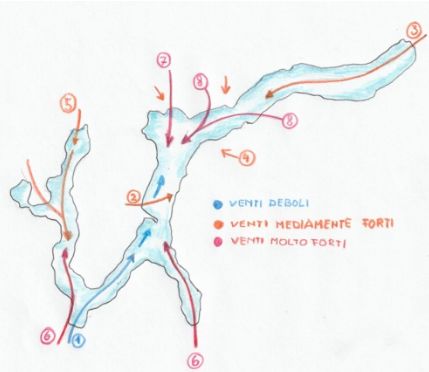
The boatman
Among the trades connected with the lake was that of the boatman, which lasted from 1819 to 1847, until i.e. the ferry boat between Bissone and Melide was in service. With the construction of the dam bridge (1847), this trade ceased.
To carry people and materials, the boatmen would make use of a large-sized boat which would take livestock, goods and even the coach travelling from Flüelen to Camerlata on board.
Those wishing to work as boatmen had to register with the municipality, who would be in charge of picking the candidates, who had to be patricians and of strong constitution.
To ensure the continuous operation of the ferry, 25 people were needed. At the Bissone end, the ferry would dock where the current Albergo La Palma is located.
To give an idea of the high activity undertaken by the ferrymen, here are the data referring to the transport from Melide to Bissone during the first 5 months of 1843:
17’217 people, 2’825 coaches, 51 four-wheel carts, 6’244 packages and sacks with goods, 461 horses, 3’694 donkeys and cattle.

The large boat used for the ferry, called a rowing port.
The boats
Two are the types of traditional boats from Lake Ceresio: the barge (known locally as barcón, porto o cumball), now no longer around, and fishing boats surmounted by wooden arches (known locally as navétt, barchétt, o barca piata).
The cumball was a large boat (14-18 m long and 4-6 m wide) and was used to carry goods, people, livestock and materials.
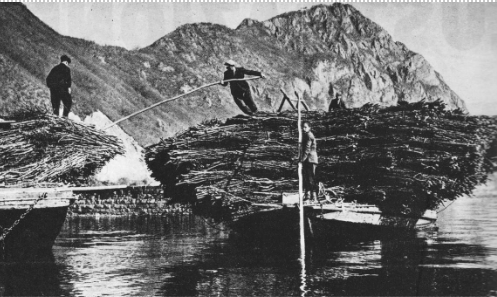
Transporting timber using the cumball, circa 1940.
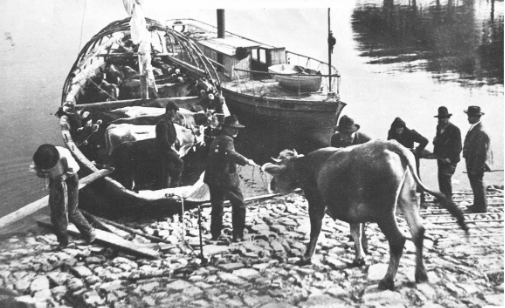
Loading cattle onto the cumball.
Fishing boats had wide, flat bottoms to facilitate the fishermen’s movements and allow them to spend their nights on board, guarding the nets or waiting to retrieve them. This shape made the boat extremely manoeuvrable, allowing it to turn easily on itself, thus facilitating the loading or setting of the nets. In case of bad weather, a protective sheet was fixed over the saddles.
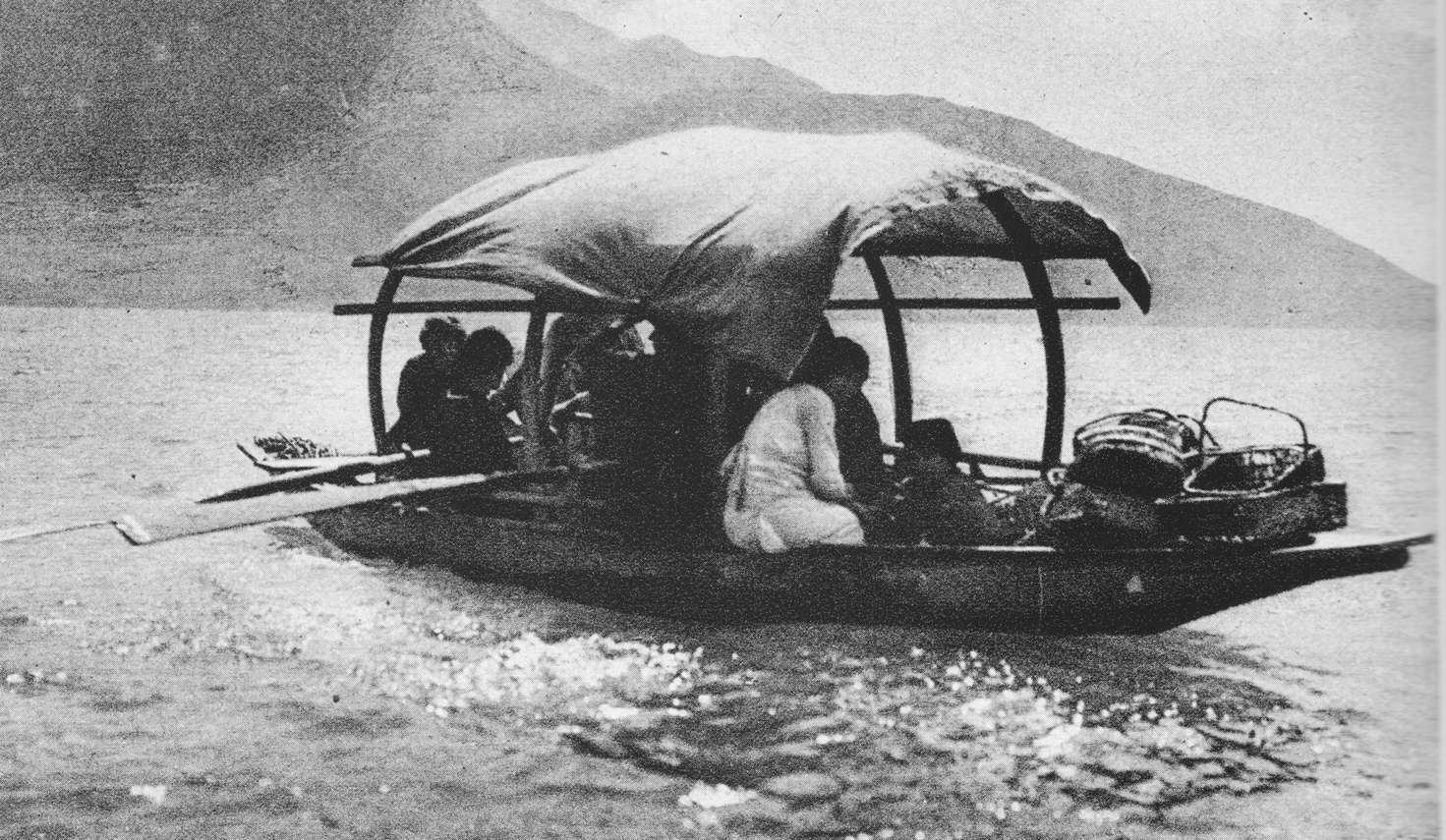
Boat returning from the Lugano market.
At the beginning of the 20th century, there was a shipyard in Bissone where boats were built, which was later moved to Campione. The construction of a fishing boat began with the preparation of the necessary materials: chestnut wood for the bottom and side planks and for the ribs, black locust wood for the edges, corners and keels. Square-section nails of various sizes were also needed – burnished to prevent rust – as well as tow or filaments of lime bark and pitch to fill the gaps between the planks (caulking). In addition to this, the skill of the craftsman was obviously essential, consisting of a thorough knowledge of the materials and extensive experience.
Fishing on Lake Ceresio
In lakeside towns, fishing was an alternative to emigration for several centuries. In Bissone, arable land was scarce and uneven, used mainly for growing vines and olive trees. For many families, fishing was their only source of income.
Even before the Second World War, around twenty families in Bissone lived solely from fishing. Since ancient times, fishing has been strictly regulated.
As early as the Middle Ages, fishermen from Bissone were subject to taxes payable to the Duchy of Milan. Each net was stamped as proof of payment and to certify the quality of the net. Strict laws were enacted, especially during the spawning season, in order to protect fish stocks. Penalties for offenders ranged from a simple fine to the confiscation of illegal nets and even the destruction of the boat.
The mere possession of prohibited nets at home was considered a crime.
Fishing with bait
Among the fishing techniques without nets, we find “tirlindana” and “spaderna”. Tirlindana is a way of fishing with the boat in motion.
It is made up of a long nylon line (60/120m) expressly leaded and called ‘mother’: from this 6/12 fragments of line ca 9 m long branch off, they are known as branches.
At the end of the branches, we find the baits which are shiny blades purposely shaped so that when moving they look like real fish.
It is immediately clear that the right speed of the boat is extremely important in that it must provide the right leap to the fake fish.
Being knowledgeable about the lake floors is also important to avert the risk of getting the bait caught on some wreck.
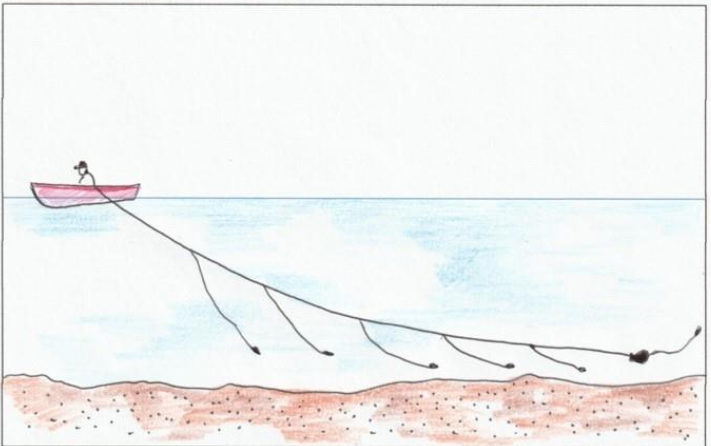
La tirlindana

La spaderna
The spaderna is based on the same principle as the “tirlindana”. However, unlike the tirlindana, the spaderna was a type of fixed fishing gear used at specific times of the year for eel fishing. Side lines about 50 centimetres long, equipped with hooks and bait, are tied to a main line 50-100-150 metres long. The main line is supported by floats every 15-20 metres, forming garlands.
Before artificial bait appeared, fishermen knew how to use a wide variety of bait depending on the type of fishing: unsalted polenta, mashed boiled potatoes, pieces of skin shaped like small fish, earthworms, larvae, beetles, crickets, cheese, in short, everything that nature had to offer.
Fishing with net
The earliest nets used on our lakes were made of hemp, linen and even silk. Then cotton came along, and finally nylon, the sturdiest of them all, durable and practically transparent in water.
The nets used on Lake Ceresio were of four kinds:
- those used in the middle of the lake to catch trout, whitefish, shad and arborella. One example is what is known as ”bedina”, a net up to 130m long and 35m high that would be lowered from two boats which would then be steered to form a sort of sack that would trap the fish.
- bottom trawling nets, used for shore fishing. By way of example, we have “antanèla”, which is 15-20 m long and 1 m high, with small pebbles at the bottom.
- gill nets, such as for instance “tremagín” (triple nets with different meshing), used as bottom trawling nets especially to catch perch, tench, carp and pike; these nets are stretched vertically by way of leads at the lower end and corks at the upper end.
- purse seine nets, such as “bottéra”, are 50-60 m long with purse-like wings and very tight mesh, corks on top and heavily weighted with leads down below.
After use, the nets would be tidied, cleared of algae, repaired, let dry on a series of permanent posts on the lake shore. Fishermen would involve their families in these activities.
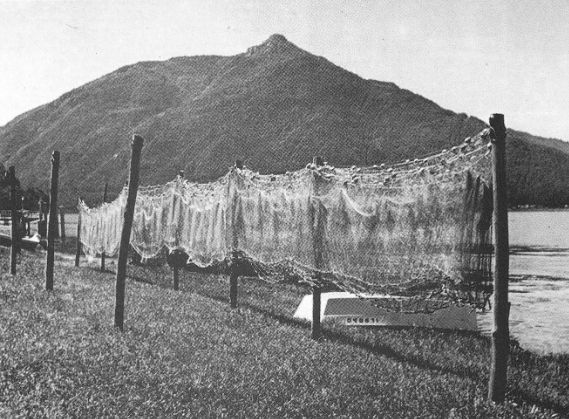
Nets hung out to dry in Bissone
